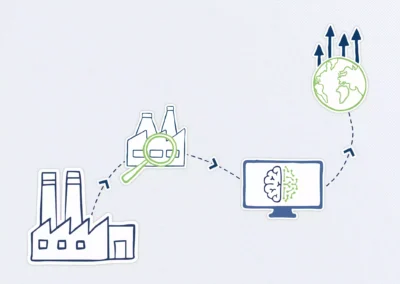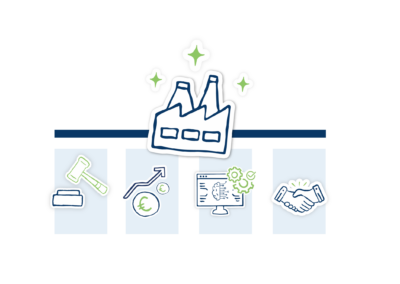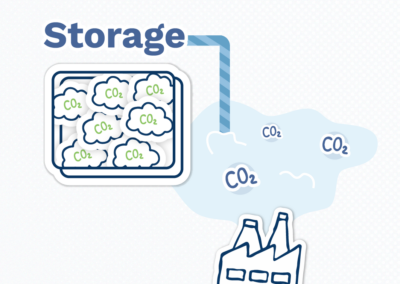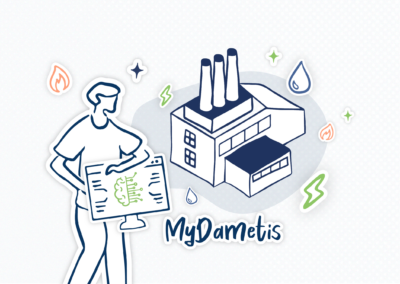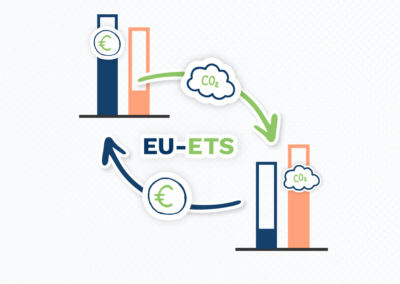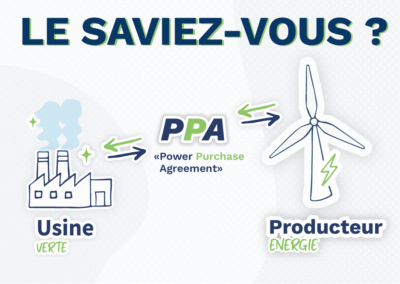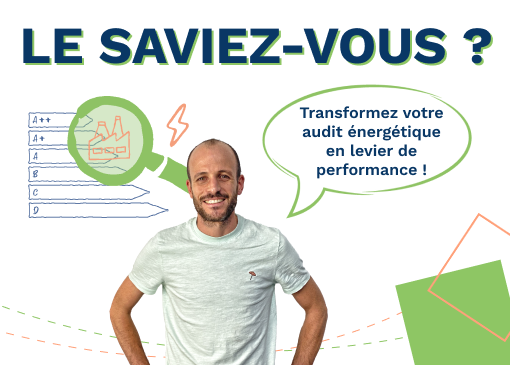
Energy Optimization in the Manufacturing Industry: Our Tips for a Successful Audit
The Benefits of Energy Optimization in the Manufacturing Industry
In today’s rapidly evolving context towards a more sustainable future, energy efficiency has become a priority for many manufacturing industries. To understand how to best exploit the benefits of energy efficiency, we interviewed Cyril Quemeneur, energy engineer at Dametis. With his extensive experience in conducting energy audits and implementing energy efficiency measures, he shares valuable tips on how companies can optimize their energy consumption and transform their practices for a greener future. Discover the interview below.
As an expert in energy audits, what are the main challenges you observe in the manufacturing industries when it comes to implementing the recommendations from the audit?
One of the main challenges I encounter when implementing the recommendations of an energy audit concerns resources. Often, industrial employees lack the time to address these recommendations as they are fully absorbed by their daily production obligations. The machines must keep running, and there is generally no time allocated for these additional tasks.
The lack of investment in the energy sector is also a challenge. This lack of investment is closely tied to the first point, as the human resources needed to implement the recommendations are often already assigned to other crucial production tasks.
Currently, with rising energy costs, companies are starting to look more closely at the energy cost of their finished products. They are seeking to understand and control the ancillary costs associated with production to improve their profitability.
Another challenge is the lack of metering on sites. Often, companies know their overall monthly consumption but do not have sufficient data to understand consumption variations. For example, they may not know if an increase in the plant’s consumption from one month to the next is normal or if the energy-saving actions they have implemented have been beneficial.
The energy audit thus allows for an assessment of energy consumption. It provides a detailed breakdown of energy consumption and identifies the main areas of consumption in the plant. Once this information is obtained, a more precise analysis can be made to identify what works well and what needs improvement, in order to implement measures to reduce energy consumption.
The ultimate goal for the client or manufacturer is to have a roadmap to improve the energy or environmental performance of their plant in the short to medium term, helping to prioritize investments and identify investment aids, often unknown to manufacturers.
In your opinion, what are the most common mistakes made by companies when undertaking an energy audit?
In the context of regulatory energy audits, which have become mandatory for certain large companies, we have noticed a common mistake made by these companies. The perception of this obligation as a mere constraint has led some companies to rush to the first available audit firm online, often without verifying the auditors’ expertise. Their main objective was simply to obtain the approval stamp to comply with regulations, without really expecting concrete benefits from the audit in terms of energy optimization.
Because of this regulatory context, many companies have not taken the audit recommendations seriously, whether they were beneficial or not. That being said, it should be noted that we cannot entirely blame them for this, as these audits were introduced in a different energy context at the time.
Another common mistake companies make when undertaking an energy audit is the lack of preparation. An energy audit requires a pre-audit data collection phase, which is crucial for its success. Often, companies do not spend enough time on this preparation phase, which can affect the quality of the audit. To obtain the best possible audit, it is important to dedicate preparation time to data collection, as well as meeting with various company stakeholders (CSR, Maintenance, Quality, etc.).
Lastly, energy being somewhat sidelined in companies, this regulatory audit came as an additional burden for people in the company who were not really prepared or trained (maintenance, CSR, QSE, etc.).
What are the key factors to consider when implementing the recommended energy optimization measures?
Financial planning is another crucial factor. Some actions may require significant investments, ranging from hundreds to millions of euros. Such decisions cannot be taken lightly. It is necessary to prepare a solid case, with the help of experts if needed, to present to management. This case should highlight all the selection criteria, including investment costs, environmental impact, and equipment lifespan. Each company will assign different weights to these criteria when making decisions. The audit will also help detect possible investment aids (CEE, ADEME, etc.).
“This is where the expertise of professionals like those at Dametis can be very helpful. These experts can help prepare the case for management and can also propose technical solutions for smaller-scale actions, bringing different scenarios to the discussion table.”
In an energy audit, Dametis experts identify several potential actions to save energy and develop an action plan. These actions can have different variants and scopes depending on the level of investment. Dametis experts focus on proposing energy optimization actions tailored to each plant, taking into account its specifics, sector, operating mode, and needs. Each plant is unique, and energy efficiency measures must be adapted accordingly.
What are the long-term benefits for industries that invest in energy improvements based on a thorough audit?
Investing in energy optimizations after a thorough audit offers many long-term benefits for manufacturing industries.
First, it allows for the establishment of a roadmap or action plan to be implemented in a relatively short time. This gives companies a clear vision of the measures to be taken to improve their energy efficiency and helps them track their progress.
Furthermore, the energy audit provides the first steps for manufacturers to improve their consumption monitoring by defining key indicators. These indicators help regularly measure and evaluate the company’s energy performance, facilitating informed decision-making and identifying areas where improvements can be made.
In terms of short-term benefits, the energy audit provides a snapshot of the company’s current consumption. This includes identifying the main energy-consuming areas, which allows targeting areas where efficiency gains can be achieved quickly. By optimizing these consumption areas, companies can achieve immediate energy savings and reduce their operational costs.
“The energy audit helps to better understand these main consumption areas. Moreover, if the site lacks metering, it allows moving from a very macro view to a detailed consumption breakdown by area.”
Finally, the energy audit enables companies to assess the efficiency of their production means in the short term. By identifying energy bottlenecks and inefficiencies in the production process, companies can take corrective measures to improve their energy efficiency. This results in more efficient use of resources and reduced production costs, enhancing the company’s competitiveness in the market.
These measures allow them to improve their profitability, reduce their carbon footprint, strengthen their reputation, and position themselves competitively in the market.
Regarding sustainability and energy transition, what advice would you give to industries to adopt a proactive approach to energy efficiency?
To take a proactive approach to energy efficiency in the context of energy transition and sustainability, I would advise industries to to focus on accurate measurement of their energy consumption. Before implementing solutions to improve energy efficiency, it’s essential to have clear and accurate data on the equipment that will be affected by the work. This means measuring their energy consumption both before and after the solutions are implemented.
In addition, I would recommend the installation of meters and the use of a tool like MyDametis (energy management software). This tool will allow for more efficient use of this data and a detailed understanding of consumption areas within the industry. This facilitates the identification of areas that need improvement and helps establish more effective and targeted energy efficiency strategies.
The MyDametis software helps understand operating modes, maintenance, and prevent deviations that may occur.
Imagine having specialists working 24/7 on optimizing your industrial sites. This is what MyDametis offers, the only platform designed 100% by environmental performance experts.
How to conduct an energy optimization audit?
What advice would you give to companies considering an energy audit for the first time?
For companies considering an energy audit for the first time, I would recommend several key steps to optimize the process.
Choose your consultant carefully: Don’t just go to the first control firm you find. Take the time to research consultants who have relevant experience and specific skills in the field of energy efficiency.
Clearly define your objectives: Before starting the audit, it is essential to understand clearly what you expect from this exercise. What are the expected deliverables? What are your goals in terms of energy savings and efficiency?
Prepare well: It is crucial to gather as much information as possible before the auditor arrives. This includes energy bills for the past three years, production data, results of any study related to energy efficiency, as well as your dashboards
Involve your whole team: Energy management shouldn’t be the responsibility of just one person. Involve different departments such as maintenance, quality, financial management and environment in the information gathering and auditing process. This will ensure a more holistic perspective of your energy practices.
Accompany the auditor on site: Your team knows your site better than anyone else. Help the auditor understand the different aspects of your plant and guide him to the relevant areas. This will enable the auditor to understand your specific issues more quickly and identify more effective solutions.
“Remember, an energy audit is an opportunity to learn and improve. Approach it with an open, proactive attitude, and you’ll get the most out of it.”
Why call on Dametis?
Dametis’ main strength lies in our holistic approach to energy efficiency. While an energy audit is often the first step in any energy optimization process, our expertise goes far beyond that.
Our experts, with extensive audit experience, can offer a comprehensive audit tailored to each site, based on its activity and specifics. Our ability to propose relevant improvement actions, grounded in our concrete experience, is a major asset. However, what truly sets us apart is our capability to implement these actions and commit to their long-term performance.
This is where our MyDametis tool comes into play. When a client decides to implement one or more actions identified during the audit, we start by taking measurements to fully understand the current equipment’s performance. Once the work is completed, we continue measuring to optimize the new installations and verify that the projected energy optimizations and savings are indeed achieved.
Lastly, we have in-depth knowledge of various financial aids related to energy. We can thus help you maximize your investment by guiding you through the application for these aids.
In short, choosing Dametis means selecting a partner capable of supporting you throughout your energy optimization process in the manufacturing industry, from the audit to the implementation of actions, including performance monitoring and optimization of financial aids.
Blog
Discover our latest articles
Your transition environmental brick by brick.
More Dametis
Languages
© 2022 Dametis – Design: J.D. Design & Graphic Designer Dametis – Realization: WordPress Freelancer










